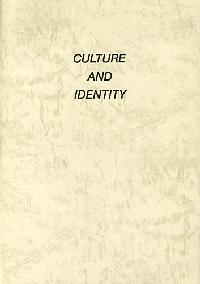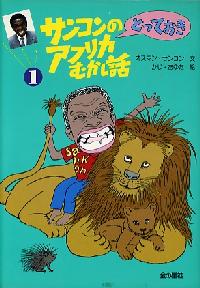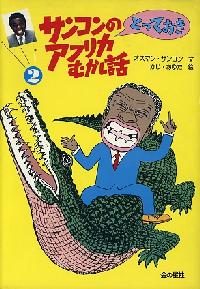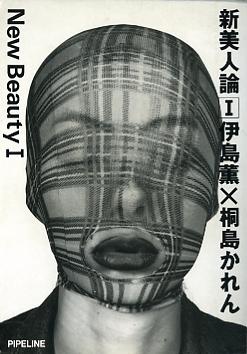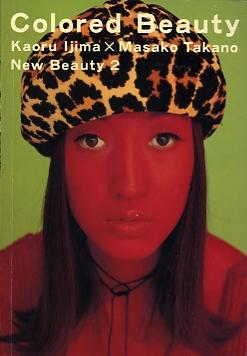Racialization
By William Wetherall
Race is a pigment of the imagination. It is real, though, in the minds of many writers and readers, all over the world, of fiction about characters who are racialized according to their skin color, region, nationality, parentage, or religion.
Skin color black, white, yellow
Region African = black, Asian = yellow, Euroamerican = white
Nationality Nigerian = black, Japanese = yellow, American = white
Parentage black/yellow = black, black/white = black,
yellow/white = yellow to whites, white to yellows
Religion Jewish = Jews as race
Ad infinitum ad nauseam.
Race is more than a construct
Race is everyone's favorite notion to defend or deny. An American scholar in Japan who has written a lot on the topic of racism has stated that "While the concept of race as biological entity has been dismissed by most scientists as little more than science fiction, the realities of race as a social construct continue to a shape the popular Imaginary" (John G. Russell, Gifu University, "Race In Japan: Changes and Challenges" symposium, Sophia University, 4 March 2006, Abstract).
In the United States, however, race is more than a construct for many biologists and social scientists. In fact, race and ethnicity have become primary commodities, promoted by all manner of researchers and policy makers, and marketed by race quota merchants in the diversity industry.
America's growing investment in multiculturalism has come to heavily rely on race boxes, now mandated not only on national census forms, but also on forms used in many federal and federally-funded programs. Virtually all states and sizable municipalities, and most public agencies and many private companies, now use race-box data to compute "measures of diversity" for their residents, work forces, and markets.
Racial Privacy Initiative
In 2002, a signature drive in California succeeded in putting the Racial Privacy Initiative known as Proposition 54 on the state's October 2003 ballot. This campaign to outlaw race boxes was begun by Ward Connerly, a businessman whose parents are racially different and who dislikes being racially classified.
Connerly, appointed to a 12-year term as a University of California regent in 1993, headed the campaign that led to Proposition 209 on the November 1996 ballot. The referendum, which won by a margin of about ten percent, banned the use of race in state employment, education, and contracting. The University of California, and other state schools, were no longer allowed to admit students on the basis of racial preferences or quotas.
The passing of Proposition 209, also called the California Civil Rights Initiative, was a wake-up call for advocates of race-based affirmative action. Proposition 54, the Racial Privacy Initiative, sought to remove race boxes from state and local government forms by 2005 and otherwise bar California from gathering racial data on students and employees. The proposition lost by a margin of about ten percent.
Race not science fiction
Forms used to enroll children in public schools have questions about race and ethnicity. Applications for state colleges and universities, and for city, county, and state jobs, also solicit such information. Forms ask not only whether one is black, white, Hispanic, or Asian, but whether one is Japanese, Laotian, and the like. There are more a dozen classifications.
Minority advocacy organizations saw the anti-race-box movement as another effort to weaken their political power, by depriving them of the means with which to measure the populations of the "groups" or "communities" they claim to represent. They were not alone in their rally against the Racial Privacy Initiative. Many medical and social science professional associations joined the campaign to defeat the proposition by publicizing their views that race-boxes are essential to their research.
This is not science fiction, but political reality. And as seen in the narrow passing of Proposition 209, and the narrow defeat of Proposition 54, race is a highly divisive issue in the United States. The American obsession with race is the legacy of over two centuries of racialization by race boxes.
Race in Japan
All that need be said about race in Japan is that, fortunately, there are no race boxes in the country. Neither race nor ethnicity have been matters of law. Both have always been strictly private matters. And this is as it should be in any civil society.
Counter reports
Here you will find my critiques of movements within the United Nations, and among advocacy organizations in Japan, to racialize Japan and Japanese law, in accordance with their interpretations of the International Convention on the Elimination of All Forms of Racial Discrimination (ICERD). The critiques are reviews of the replies by the Japanese government to requests by the Committee on the Elimination of Racial Discrimination (CERD), which oversees compliance with ICERD. They also examine the counter reports that advocacy groups submit to CERD in their movement to pressure Japan to accept their views of race and comply with their demands for legislation that would in effect racialize Japan.
Confluences of blood
In the natural world, there is no such thing as "mixed blood" between members of the same species. The most important condition of sexual reproduction among humans is to be human.
All children born of a sexual union between a man and a woman are mixtures of their parental bloods. Every mixture is at once different and identical -- different because every combination of parental genes is unique, and identical because all such combinations are singularly and purely human. Human blood -- as a metaphor for the genetic matter of human life -- is rain that flows through social terrains into the same lakes and oceans.
Sexual attraction has little regard for socially erected barriers between human populations defined by race, religion, class, caste, or taste in music. Attraction across racial, religious, class, and other such borders is a natural defense against the sort of social intervention in the propagation of the species that would differentiate humans into subspecies and prevent them from sexually mixing.
All children are of "mixed blood". Children born of any union between parents from socially different subspecies are no different than children born between parents from the same putative subspecies, in that they represent mixtures of their mother's and father's human genes. All are the consequences of love, arrangement, impulse, or coercion. And all are blessed with the same chance at life -- but not the same chances.
Societies differ in how they encourage some unions, and discourage or even criminalize others, according to a couple's races, religions, or classes.
| Racialism and racism |
|
Racialism is what takes place when you regard yourself and others as racial entities. Racism is what occurs when you treat people differently on account of how you perceive them racially. Differentiating racialism from racism helps understand how multiculturalism is deepening racial consciousness in many countries, with help from the United Nations. As racism decreases in the United States, racialism is increasing with official vengeance in the form of more race boxes and greater racial consciousness in public life. The American disease of racial classification and racialized law is trying to swim the Pacific, as the mobile bacteria of racialism proliferates and seeks a new host. Here you will find a few articles that attempt to illuminate the disadvantages of racialism, and why racialism so easily manifests as racism. |
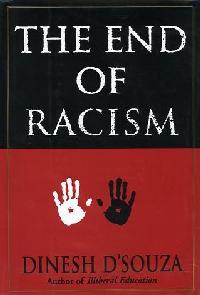
Dinesh D'Souza The debate on race in America is dominated by Americans who consider themselves victims of racism. With few exceptions, authors dispute "race" as a "scientific" concept, bemoan discrimination made in its name, but still conclude that "race" should be grounds for preferential treatment of minorities in employment and college admissions, and people should still be asked their "race" on national census and other forms. Dinesh D'Souza thinks otherwise. An Arizona high-school exchange student from India at age 17, he went on to major in English at Dartmouth College, by 26 was a senior policy analyst at the Reagan White House, and became a US citizen in 1990. In 1991, D'Souza's Illiberal Education: The Politics of Race and Sex on Campus exposed the intellectual poverty and intolerance that was sweeping American higher education as a result of radical student and faculty politics. It came in the wake of Allan Bloom's The Closing of the American Mind (1987), and other conservative laments about the ill effects of radical feminist and ethnic movements in academia, but focused on the impact of political correctness. Whereas Bloom and many other opponents of the minority politics that was changing the face of American "traditions" were categorically dead or dying white males, D'Souza was a bona fide "immigrant" and "person of color" whose only fault was being a male new conservative. What he wants to conserve, however, are the principles of freedom, and the separation of public and private, that he feels are essential if any kind of true "diversity" is to work. ContentsThe End of Race, in many ways a sequel to Illiberal Education, has thirteen very punchy chapters.
1. The White Man's Burden:
The Collapse of Liberal Hope
2. Ignoble Savages:
The Origins of Racism
3. An American Dilemma:
Was Slavery a Racist Institution?
4. The Invention of Prejudice:
The Rise of Liberal Antiracism
5. A Dream Deferred:
Who Betrayed Martin Luther King, Jr.?
6. The Race Merchants:
How Civil Rights Became a Profession
7. Is America a Racist Society?
The Problem of Rational Discrimination
8. Institutional Racism and Double Standards:
Racial Preferences and Their Consequences
9. Is Eurocentrism a Racist Concept?
The Search for an African Shakespeare
10. Bigotry in Black and White:
Can African Americans Be Racist?
11. The Content of Our Chromosomes:
Race and the IQ Debate
12. Uncle Tom's Dilemma:
Pathologies of Black Culture
13. The End of Racism]
A New Vision for a Multicultural Society
D'Souza is an ardent a supporter of freedom of association and expression. Though an enemy of multiculturalism, he passionately defends the idea of a multicultural society. He embraces the principle of equal opportunity in employment, and because he takes "equal" seriously, he opposes affirmative action based on racial or ethnic preference. D'Souza and WuD'Souza has publicly debated Frank W. Wu, who favors some degree of affirmative action. Wu's remarks about D'Souza reveal their common experiences (Yellow, pages 84-85).
Also a flaw in Steamy East fictionWhat Wu points out also happens to be one of the more common flaws in Steamy East fiction, especially stories that feature American (or whatever) protagonists whose ancestors include one or more people of Asian descent. Very often their ancestry is a pretext to lace the stories with commentary on the lives of, say, "Chinese" or "Japanese" in America (or wherever) if not in China or Japan. The stories are contrived by mostly white writers to provide mostly white readers with vicarious "Asian" thrills as the reader is guided through this or that Chinatown or Zen experience by protagonists who must do double duty as ethnic tour guides. Though Americans or British or whatever, they remain what Wu calls the "perpetual foreigner" in their own country. Though Wu wrote Yellow some 7 years after The End of Racism, he shows less willingness than D'Souza to get down and dirty about the true nature of the racist beast in all racial cohorts. D'Souza's book is not without flaws, one of which is his all but exclusive focus on white/black relations. But he is flawless in his expose of the fallacy that only whites are capable of racism. And unlike Wu, he has no qualms about plunging into the murky waters of minority pathology, in his argument that there is much more to "racism" than race. (WW) |
| Race boxes |
|
Race boxes are boxes, or simply blank lines, on registration, application, and other forms, used by national and local governments, and public and private organizations, to solicit and collect data on the race and/or ethnicity of the people who the forms concern. Most states do not consider the "race" or the "ethnicity" of their nationals to be government matters. In Japan, for example, neither race nor ethnicity have been matters of law, and the state does not label people other than by their nationality, which is purely civil status. The United States, however, has a long history of the use of race boxes by the federal government, and in turn by state and local governments and agencies, and public and private organizations, to discriminate between people on the basis of their attributed of self-acknowledged color, race, or today also ethnicity. Race boxes have proliferated as official racialization expands its list of "races" which, today, are "empowered" by official recognition. The United States has led the world in the racialization of its people, in national censuses taken every ten years from shortly after establishment of the country on the foundations of slavery in the late 18th century, to the present 21st century. Fortunately, most of the world has not followed America's racialist policies, which continue to find new ways to express old pretexts for racially classifying people. I personally consider race boxes the most salient symptom of formal racialism and racism -- racialism and racism nurtured by legal mandates to racially classify people and to treat them according to their racial classification. |
| Race in constitutions |
|
How do constitutions of states treat "race"? As an object of classification? Or as object of non-discrimination? Or as both -- as contradictory as this may seem? United StatesThe original US constitution differentiated between free persons, who counted as full-persons, and others who counted as only three-fifths of a person, for purposes of apportioning congressional representation. This distinction was not, on the surface of federal law, based on race, as there were free blacks and un-free whites. Moreover, the main object of the US constitution was to define the structures and mechanisms of the US government as a federation of states which had their own constitutions and laws. The words "race" and "color" appear only in Amendment XV of 1870, which five years after the Civil War held that "The right of citizens of the United States to vote shall not be denied or abridged by the United States or by any State on account of race, color, or previous condition of servitude." This followed Amendment XIV of 1868, which repealed the "whole" and "three fifths" distinction. In many ways, however, US federal laws have either directly practiced, or have aided and abetted states in their practice of, racializing people and discriminating between people according to their putative race. While the federal government has in many ways helped end racial discrimination in American states, it exacerbates the racialization of people by continuing to mandate the use of race boxes on national census and other forms. CanadaForthcoming. JapanJapan's 1889 constitution said nothing about "race" and Japan's early laws did not racialize or otherwise discriminate racially. It's 1947 constitution prohibits discrimination under law because of "race" and today, as in the past, its laws do not racialize people. Neither race nor ethnicity are legal entities. Republic of ChinaAll of ROC's constitutions have prohibited racial discrimination, but ROC has had to racialize Taiwanese aborigines within it's nationality. Legalists will argue that recognizing aborigines as indigenous people is merely an act of compliance with international treaties. They will also argue that differentiating aborigines from other ROC nationals, for the purpose of according them collective semi-sovereignty and other forms of exceptional treatment under ROC laws, is not "racial discrimination" as meant by the constitution. People's Republic of ChinaPRC's constitutions have not categorically prohibited racial discrimination, but it's laws have racialized people as members of "ethnic nations" (nationalities). All constitutions have held all ethnic nations to b equal and have prohibited discrimination between them, as well as "ethnonationalism" (chauvinism) among them. PRC legalists probably focus on "ethnic nationality" rather than "race" because they are interested in "ethnic nations" as political communities with economies, languages and scripts, mores and customs, and religious beliefs -- whereas "race" in a line-up like "sex, race, religion, or class" is a more biological trait. Republic of KoreaROK's constitutions, like PRC's constitutions, have not categorically prohibited racial discrimination. Moreover, its constitutions would seem to encourage the notion that ROK "nationals" -- though legally defined by a civil nationality that is based on household registration -- are racioethnic entities. Democratic People's Republic of KoreaForthcoming. |
| Racioethnic subnations |
Many in China, more in America, none in JapanSome states define subnations within their general nationality. When legal status as a member of such an entity is based on racioethnic (particularly biological) lineage, I am calling the entity an "ethnic subnation". North AmericaIn Canada, the federal Department of Indian and Northern Affairs Canada (INAC) -- which is responsible for overseeing the laws and policies related to First Nations, Inuit, and Northerners -- recognizes over 600 bands under the Indian Act of 1867. The act continues to provide the legal basis for status as a Registered Indian. Not all Registered Indians are members of First Nations, some 250 of which control their own registration. Federal benefits are available only to a person who is both a Registered Status Indian and a member of, or affiliated with, a treaty band. In the United States, the federal Bureau of Indian Affairs (BIA), which overseas land held in trust by the United States for American Indians, Indian tribes, and Alaska Natives, recognized 561 tribal governments as of 2007. Some non-federally recognized tribes are recognized by a state government. A number of people claim to be members of tribes or bands that are not recognized by any polity. ChinaThe People's Republic of China(PRC) recognizes 56 ethnic nations it calls "nationalities", including the majority Han nationality. Practically all Chinese are ethnonationally classified in their residence register. Some racioethnic categories, including Macanese (yถl Tŭshēng Púrén), who are people of mixed Chinese-Portuguese ancestry in Macau, and Jews (เนพ Yóutài), are not recognized. A few other categories are classified in, and therefore conflated with, one of the recognized groups. Other racioethnic minorities, including some naturalized Chinese, are unclassified. The Republic of China (ROC) now recognizes 13 aborigine peoples, most of whom reside in their own mountain and plain-land communities. The People's Republic of China collectively classifies the few thousand Taiwanese aborigines residing in its jurisdiction as Gāoshān Zú (Rฐ "high-mountain race"). JapanJapan has never recognized ethnic subnations within its nationality. Since the late 1980s, Ainu have been officially recognized as a "shosu minzoku" (ญฏฐ) or "minority race / people / nation / ethnic group" for purposes of complying with United Nations conventions that require Japan to account for the existence of various minorities in its national population. However, this recognition does not extend to individuals, as there are no legal provisions to differentiate racial or ethnic status within Japanese nationality. |
| Racial terminology |
|
All manner of words are used to express contempt for members of other nationalities and races. Labels that people of East Asian descent find offensive include Chinaman, Chink, Jap, Nip, gook, slope, and slant-eye. Words cannot themselves be offensive, however. Offense is both a matter of implication and inference. And problems arise when readers or listeners infer offense where it was not implied. |
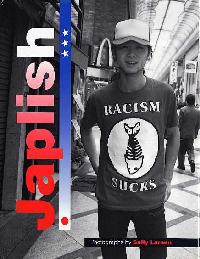
Sally Larsen A certain website styles Larsen as "A Native-American and native of San Francisco" and says that "As psychedelia blossomed, she found her way to Golden Gate Park and intuitively sought the society of artists and eccentrics." Also a martial artist and surfer, "her philosophical nature centers her aesthetics on the fusing cultures of the Pacific Rim." Larsen, apparently of mixed Apache and Aleut descent, has photographed everything from obsidian arrowheads and jizo images, to animal emulation by Chinese Kung Fu Master Xu Guo Ming in Golden Gate Park. Photo essay of a new languageJaplish presents 80 full-page black-and-white photographs, mostly of the fronts or backs of jackets, sweatshirts, and t-shirts worn by young people Larsen encountered on streets, in parks, and at temples and shrines in places like Tokyo, Osaka, Kyoto, and Nikko. Neeli Cherkovski, a resident of San Francisco with poetic inclinations, made these remarks in his introduction. Similar remarks appears on the front flap of the dust jacket. Japlish [according to Sally Larsen] is a term used in Tokyo to describe Euro-American expressions found in Japanese newspapers. English becomes incorporated, sometimes misspelled, always with eccentric phrasing. Larsen's belief that Japlish is becoming a new language used by young people to deal with the world view they share is what committed her to shaping this photo essay. She points out that the Japanese youth are fascinated with everything from Brazilian music to Elvis Presley, from ethnic African rhythm to American rap. "Japlish" not common in JapanWhile "Japlish" enjoys a higher currency of usage on the Internet, "Janglish" and "Japanese English" in English, and "Wasei Eigo" (Made-in-Japan English) in Japanese, are the expressions most commonly used in Japan to refer to the mishmash of "English" that today pervades Japanese popular culture. While made in Japan, Janglish is not, of course, English but Japanese masquerading as English. Janglish is one of many forms of English that has been bastardized in, and baptized into, other languages. Chinglish (Chinese English), Hinglish (Hindi English), Konglish (Korean English), and Singlish (Singaporian English) are other Asian varieties. Russlish, Spanglish, Polglish, and Dunglish are among many European varieties. Numerous examples of mostly Japanized and other Asianized Englishesque expressions can be found at Engrish.com. As I write this, about 12:40 on Sunday, 9 July 2006, I am watching a couple of young men sing a duet on NHK's ever-popular "Nodo jiman" show, which features amateur singers who are proud of their voice. The man singing alto is wearing a black t-shirt with the following words in huge pink letters.
|
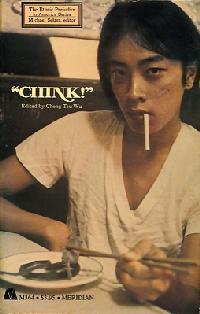
Cheng-Tsu Wu (editor) Of the several places this book could have been placed on this website, it is here because it exemplifies the sort of "attitude" that encouraged many Asian American writers to get off their butts and kick ass. Wu's documentary of prejudice against Chinese in America, and Americans of Chinese descent, not only gives reasons why they should do so, but shows how. I can think of no better way to introduce the book than by citing the beginning and end of Ben Fong-Torres Foreword (pages ix-xiv, bracketed translations in original).
Ben Fong-TorresIn case you haven't guessed, Ben Fong-Torres knows how to write. He ought to. He is one of the most famous rock journalists in the world, a writer for, then long time senior editor of, Rolling Stone magazine, as well as a San Francisco DJ and San Francisco Chronicle columnist. As Shirley Fong-Torres explains her and her brother's family name (Internet source):
The art of titlingAttitude clearly runs in the Fong-Torres family. It also runs through Wu's book -- though in a deceptively quiet manner. Wu has very skilfully stitched together an impressive variety of material to document the bland insensitivity that often characterizes "institutionalization of racial prejudice against the Chinese [that] started in California during the 1850s" and was still continuing at the time Wu was working on his book. The title "Chink!" stands without any commentary from either Wu or Fong-Torres. This testifies both to their artistry and sincerity in throwing an offensive work back at the offenders, in manner of speaking. The Missing ChinkA number of other writers have similarly been inspired to use "chink" in the titles of works that confront the nasty truths about discrimination . The Missing Chink was a four-part series of short comedy sketches produced by Mu-Lan Theatre Company for Channel 4 in London. The 5-minute episodes were telecast from 19 to 22 January 2004 at 19:55, after C4 News. It was thus timed to run through the eve of Chinese New Year, which fell on 23 January in 2004. The sketches were written by Paul Courtenay Hyu, who is Mu-Lan's artistic director. They featured Paul Chan, former Chinese Detective star David Yip, Pink Panther actor Burt Kwouk, former England rugby star Rory Underwood, and as well as Matt Wilkinson, Scott Corben, Simone Tully-Kedge, and Hyu himself. Channel 4 immediately drew a lot of flack for the title, which Hyu says he "deliberately chose . . . (having discussed the implications thoroughly with both the production company and the broadcaster, Channel 4)" because he "wanted to start a much-needed and long-awaited debate" (Mu-Lan website). Channel 4, to its credit, did not pull the final episodes. On 23 January, the day after last episode was aired, Hyu responded to his critics with a statement that is posted on the Mu-Lan website. Here the most vital paragraph.
DimSum forumSome members of DimSum, "The British Chinese Community Website", set up a forum for "The Missing Link". It raged with debate over Hyu's use of "chink" in his comedy series. One post, defending Hyu, said this.
The coverBolerium's blurb for "Chink!" ends with this remark: The author disowns the startling cover photo as having been chosen by his publisher. Photo is unattributed; Straight Arrow is upholding its in-your-face reputation. As the saying goes, you can't judge a book . . . . (WW) |
| Skin color |
|
How people differentiate and label colors and tones of skin, and the meanings they attach to the perceived differences, is the subject of numerous books and articles. |
Hiroshi Wagatsuma Hiroshi Wagatsuma (1927-1985) was one of more animated and original anthropologists of his day. Though strongly influenced by George De Vos, he had a mind of his own about social issues in Japan and how to present them in English. Wagatsuma's essay on "The Social Perception of Skin Color in Japan" was very well received when it appeared in 1967, in an issue of Daedalus devoted to the subject of "Color and Race". Edited by Edward Shils, the issue was published as Volume 96, Number 2 of the Proceedings of the American Academy of Arts and Sciences. As its table of contents shows, the "Color and Race" issue of Daedalus remains extremely valuable for students of the history of racial studies.
Wagatsuma's contribution was one of several which showed that color prejudice was not limited to Euroamerica. While his labels reflect the racialism that scholars still embrace, and though his survey of classical literature and popular culture is a bit skimpy, his article remains a classic in its own right. DisclosureI became personally acquainted with Wagatsuma a few years after this article was published. He asked Yuzuru Sasaki [Sasaki Yuzuru], a colleague in Japan, to send me the several scrapbooks in which they had collected clippings on racially mixed offspring from Japanese magazines, as they were finished with them, and I was allowed to keep them for my own research. Later, when both of us were in Japan, Wagatsuma introduced me to one of his deceased father's colleagues, who in turn introduced me to the attorneys who represented my wife at the time and our children in their nationality law suits against Japan. See Doctor's cancer dilemma: To tell or not to tell (Hiroshi Wagatsuma's final thoughts on Japanese culture and psychology) for an account of the energy Wagatsuma brought to life even as he was dying. |
| Black |
|
That there are "blacks" in Japan as opposed to "Japanese" is a highly racialist notion. That some people are "black" by any definition of race is itself racialist. But to then racialize an entire people who are Japanese by virtue of possessing Japan's raceless nationality is arguably even more racialist -- given that some Japanese are black (as opposed to white, yellow, brown, or pink), while some blacks are Japanese (as opposed to American, Chinese, Korean, or Nigerian). |
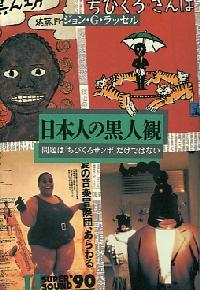
John G. Russell Forthcoming |
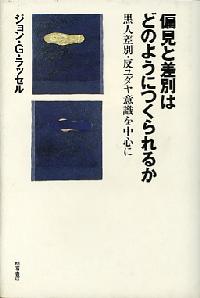
John G. Russell My main misgiving about Russell's approach to racioethnic prejudice toward "blacks" in Japan is the extent to which he attributes it mostly to influence from "whites" outside -- and the way in which he himself racializes Japanese. To be continued. |
TitleOusman Sankhon (text) Osuman Youla Sankhon came to Japan in 1972, the year he joined the foreign ministry of the Republic of Guinea embassy. He served as Guinea's ambassador to Japan until 1980, when he was sent to Guinea's Washington, D.C. Embassy. He has lived in Japan since his return in 1984, when he began appearing on television shows. "Sankon" as his fans know him in Japanese now advises the Republic of Guinea embassy, and as a member of the Japan and Guinea Friendship Association and other organizations he is active in the promotion of agriculture and other development in Guinea and other African countries. Sankhon has a set of teeth that don't stop once he open's his mouth and starts speaking in Japanese -- which took him a while to perfect to the point that other people could understand. In the front of the camera can be very serious, but mostly he plays the funny man as he tries to give his audience an impression of what it might be like to live in Africa, and what it has been like for him to settle in Japan Sankhon makes numerous cameo appearances in the illustrations in these books. During the years he appeared on television with more frequency than he does not, his face often appeared in weekly magazine caricatures of television, political, and other personalities in Japan. Sankhon trademark toothy smile and thick lips are easily caricatured -- and he would be the last to deny that he has precisely the sort of features that cartoonists throughout the world have often been criticized for presenting as typically "black" or "African". To be continued. |
| Brown |
|
The idea of a brown race is not recent. Some anthropologists classified human races as black, brown, red, white, and yellow. Others conflated red with yellow and regarded brown as a mixture or simply ignored it. Today, brown is coming back with a "brown pride" vengeance as a color for Filipinos, Malays, Polynesisians, Melanesians and other Pacific Islanders, but also for people ranging from native Australians and New Zealanders to Latin Americans, Arabs, and South Asians, among others who are not black, red, white, or yellow. |

Leon Wolff Little Brown Brother Little Brown Brother William Howard Taft, the 27th president of the United States from 1909 to 1913, referred to Filipinos as "our little brown brothers" when he served as the first Governor-General of the Philippines from 1901 to 1904. To be continued. Blurb from a US bookseller based on Oxford edition. When the Spanish-American war broke out in 1898, the Philippines -- a colony of Spain for nearly four centuries -- was already in revolt against colonial rule, and its fight for freedom almost won. However, within months of Philippine independence being proclaimed, the country was confronted by a fresh challenge: America's determination to establish sovereignty over it. Having no desire to exchange one colonial master for another, the country resisted annexation and by early 1899 the Philippine Insurrection had erupted. When it ended in 1902, some 230,000 people (of whom 225,000 were Filipinos) had lost their lives in a war that was one of the most prolonged and deadly in the annals of empire, and with consequences which last to the present day. How it all came about and how the white man subdued his 'little brown brother' in his war of conquest are mordantly told in this vivid and closely documented narrative. First published in 1960, Little Brown Brother won the Francis Parkman Prize from the Society of American Historians in 1962 as the book which 'best combined serious historical scholarship and literary distinction'. |
| Blue |
|
Blue is the color your skin turns when you become depressed by all the energy that more people appear to be investing in racial pride. One clever way to undermine the idea of race is to show that skin comes in practically any color you can name. |
Ijima Kaoru The photographs were taken on 28 November 1991 at Bunka Publishing Bureau studio, for publication in one of the company's fashion magazines. Ijima, though, decided he also wanted to publish all the photographs -- "all 450 frames, including three that were defaced because of a shutter problem" (as written in English). The book is thus very thick, and each photograph, one to a page, shows Karen Kirishima with some sort of stocking or net pulled down over her face, which therefore is mostly covered and usually contorted. I can't think of a single reason why anyone would want to see any of the photographs. Ijima Kaoru (text) This book features photographs of 26 models representing as many colors of people. 26 more racesMahogany Emerald green Akane-iro [madder red] Canaria-iro [canary] Daidai-iro [orange color] Rose Lilac Rose pink Aqua Ice blue Nutmeg Yu-chie-hon [yuejihong, rose red] (3rd Zyappu) Ruri-iro [lapis lazuli] Scarlet Wasurenagusa-iro [forget-me-not] Moegi-iro [light yellowish green] Cherry (Akira, cover of this book) Cobalt blue (1st Zyappu) Strawberry Turquoise blue Tanpopo-iro [dandelion] Botan-iro [peony] Sango-iro [coral] Orchid Malachite Lemon-iro [lemon] (4th Zyappu) The photographs were taken through filters to give them different colors. They were shot from 22 February 1993 to 24 November 1994. In his preface, Ijima writes this. The color of human skin is divided into black, white, yellow as though this were natural, and this gives birth to racial discrimination. So what would it be like if there were many, say 20 or 30 colors? Many of the photographs taken for this project were used as covers, and in articles in the first several issues, of the quarterly fashion and photograph magazine Jappu, which debuted in January 1994 about halfway through the project. Jap Magazine, as it was called in English, was edited by Iijma and published by Korinsha. See Jap, Jappu, and Zyappu: A lexicon of pride and prejudice for a full report on the rise and fall of Zyappu magazine. |
| Red |
|
"Redman" remains a controversial label for American Indians. If sometimes associated with "wild Indian" it has also been a term of respect and even pride. While some people consider "redskins" a disparaging term, it is still the name of football teams like the Washington Redskins. "Red power" has been a rallying call of American Indian movements since the late 1960s, and "red pride" has also gained some currency. Alarmist expressions like "red peril" and "the reds are coming" warn of the threat of communism. |
| White |
|
The humorist Mark Twain, who winked very seriously at the human condition, didn't think much of whiteness, and saw darker skins as more beautiful. There is currently a backlash of "white power" by people who consider themselves members of a race that in some sense has become "invisible" the racial politics of the United States if not the world. Books have been written about the "white peril" and the "white power movement". |

Richard Dyer Forthcoming. |

Karyn McKinney Forthcoming. |
| Yellow |
|
"Yellow" is associated with more than peril, cowardice, and jaundiced teeth. "Yellow power" has several meanings, including ethnic empowerment. E.H. Kim at UC Berkeley coined "Yellow English" to refer to the mock, pseudo English Charlie Chan and other such characters are made to speak in fiction and film -- which I prefer to call "yellow-face English". And in Japan, "The Yellow Monkey" [(Za Ieroo Monkii) band, nicknamed "Yemon" [Iemon], dazzled rock fans from 1988 before disbanding in 2004. See the Steamy East website for reviews of "yellow peril" as an image in English fiction. And read on. |
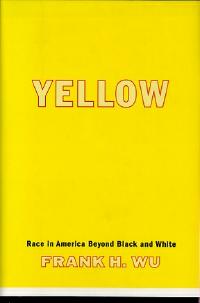
Frank H. Wu The jacket of this book bills Frank H. Wu as "the first Asian American to serve as a law professor at Howard University Law School" -- which will mean something to readers who recognize that Howard University was charted by the US Congress in 1867 as "a college for the instruction of youth in the liberal arts and sciences". The "youth" were mostly freed slaves and free-born blacks, and today the college remains predominately African American. While Wu's post at Howard may serve to establish his qualifications to speak on "Race in America Beyond Black and White", it also suggests that he had to break one color line at a university created after the Civil War to defend another. ContentsThe table of contents fairly represents the scope of Wu's concerns. 1. East Is East, East Is West: Asians as Americans 2. The Model Minority: Asian American "Success" as a Race Relations Failure 3. The Perpetual Foreigner: Yellow Peril in the Pacific Century 4. Neither Black Nor White: Affirmative Action and Asian Americans 5. True But Wrong: New Arguments Against New Discrimination 6. The Best "Chink" Food: Dog-Eating and the Dilemma of Diversity 7. The Changing Face of America: Intermarriage and the Mixed Race Movement 8. The Power of Coalitions: Why I Teach at Howard Epilogue: Deep Springs This book is a thought-provoking (rather than merely provocative) tour de force. Wu, a dog lover, says this about the question of whether it is possible or proper for multiculturalists to censure the eating of dogs as a practice in certain Asian settings (page 216). I am appalled both by the idea that anybody would eat dogs and by the question of whether Asians eat dogs. How we [Americans] as a society address the taboo on dog-eating presents an excellent case study for contemplating the meanings and limits of diversity in all its forms. Dog-eating is neither as easy to tolerate as chopsticks instead of silverware nor as easy to forbid as violence against women justified as a venerable custom. Do Asians eat dogs?Wu prefers not to dignify the question "Do Asians eat dogs?" with an answer, but to ask "What is the point of asking whether I eat dogs?" -- thus cross-examining what he calls the "accuser" -- for such questions are directed at putatively "Asian" people as though to imply, "You're Asian, do you eat dogs?" Wu goes on to explore the extent of dog-eating as a "cultural practice" -- but fails to point out the flaws of such cultural reductionism, though his own conclusions about the nature of the groupist beasts that tug at all individuals clearly show that he understand the shortcomings of "culture" as concept (page 229). Both assimilation [to an Anglo-American standard that may eschew eating dogs or whatever] and multiculturalism [which embraces the voguish but vague concept of "diversity" (page 227)] is inherently and thoroughly good or evil. Both can become authoritarian, each obeying its own authorities. Assimilation and multiculturalism both have their leftist and rightist variations. Together, they place Asian Americans in a no-win bind between being "all-American" and being "gooks," being ordered one day along the lines, "You should just be an American," and being pitied another day with, "It's too bad you've lost your culture." Universalism and individualismWu does not believe that "being Asian" or anything is foreordained. He returns to this theme most eloquently in the Epilogue, where he talks about his experiences teaching at Deep Springs College, a very unusual school at the edge of Death Valley in California, an hour's drive from the Cottontail Ranch, a brothel in Nevada. Wu reflects on the meaning of a universalism that tolerates multiple subcultures (page 347). Universalism can overcome our tendencies toward self-interest, group-interest, and the meanness of bigotry. It may be the only treatment for the conceit from which almost all of us suffer, which causes us to prize our ancestry as if our name by itself gave us the claim to superiority. Asian Americans need an antidote to this arrogance as much as anyone else. And in his concluding paragraphs, he defines the parameters of the sort of individualism that true universalism fosters (page 348). A genuine individualism . . . can be neither imitative nor imitated; it cannot be parochial. It cannot be the product of either coercion that forces a conception of ethnicity upon a person or a contrary compulsion that induces a rejection of ethnicity in a person. It cannot be assimilation of an ordinary type, demanding uniformity with an external set of norms, any more than it can be multiculturalism of a crude type, insisting on submission to an inherited set of customs. Individualism also cannot be too egotistical, retreating into narcissism and solipsism. One rarely finds such endorsement of universalism and individualism in books ostensibly about specific racial or ethnic groups -- as this one seems to be, if all one reads is the blurb on the jacket, which quotes Wu as saying: "Asian Americans can be agents of our own destinies, insisting that we are ourselves and refusing to be either black or white." In fact he says so much more. (WW) |
Yellow World
Yellow World's splash page asks "What color is your world?" And it states that the website's mission is "The cultivation of a political Asian consciousness".
Yellow World does not appear to be often up-dated and may in fact be inactive. Though some links produce articles, most links loop back to the top of the splash page. The forums include rants on Charlie Chan and Lost in Translation and other topics germane to Steamy East fiction and film, but access is limited to registered members.
Some "yellow" websites that are no longer on-line include "www.freeyellow.com", "asianprideforever.freeyellow.com", and "www.chink-o-rama.com".
| Interracial romance |
|
The only imperative more powerful than racial and other causes of prejudice is sexual attraction. Interracial sexual attraction is the most persuasive evidence that race has no biological significance for humans as a species. Interracial unions have become so common, and generally accepted in the more cosmopolitan places of the world, that most urban people pay little attention to the sight of an interracial couple in public. While such unions may be in on the increase, they have never not taken place. For as long as there have been geographical races, there have been many forms of intercourse between such races, in the form of commerce if not war, and inevitably sexual unions if not also marriage, and at times even romance. Books and other materials reflecting romance and marriage between Asians and non-Asians, including guidebooks on courtship, and mail-order bride publications and advertising, will be revealed here. See Miscegenation under "Raciosexual images" in the "Images" section of Steamy East for reviews of books and commentary on interracial unions in English fiction. |
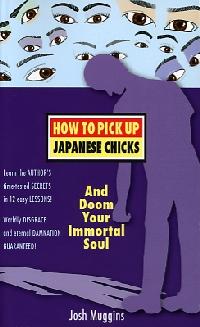
Josh Muggins "Learn the author's time tested secrets in 12 easy lessons! Worldly disgrace and eternal damnation guaranteed!" -- the cover blurb assures us. Muggins delivers on his promise, for the Contents lists 12 lessons rather than chapters.
1. Get your sorry white ass to Japan
2. Do not be furry
3. Be used and discarded like a mindless tool,
and learn to love it
4. Don't do anything
5. The cistern of your lust
6. Know when to fold 'em
7. The fear of God
8. First, do no harm
9. Reality is not your friend
10. Honor thy father and thy mother
11. Or Stage Five -- The Moment of Clarity
12. The cabinet of Dr. Katagiri
Sexual and racial laughsMuggins promotes himself -- and this book -- on his own website, which informs the web world that "Former college professor and published writer Josh Muggins protests too strongly that How to Pick Up Japanese Chicks and Doom Your Immortal Soul should not be mistaken for a self-help manual. In fact the smiles, the belly-laughs, the wistful there but for the grace of God go I nodding that every page elicits testify that it is the best sort of therapy for anyone suffering from relationship fatigue anywhere, anytime." I stumbled across Muggins' site while trying to find information bearing on the question of whether the dribble he wrote was confession or fiction. I'm still not sure. Even if confession, it would be read better -- if you can stomach Muggins' brand of sexual and racial humor -- as fiction. All about meConfession or fiction, the book becomes totally narcissistic from page 7. As a footnote to the very last line of page 6 warns: "Awkward transition alert. Brace for a shockingly amateurish shift in tone. At this point, the book abandons all pretense of addressing the reader's needs and becomes all about me, me, me." (WW) |
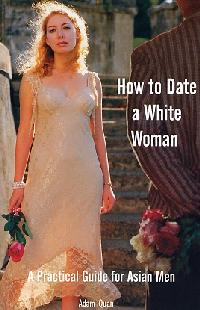
Adam Quan The back cover tells us that "Mr. Quan is an International Business Consultant" who has "travelled and worked in many countries". For "more than fifteen years, he has successfully dated women in many nationalities." The books proves "his observations in dating White women and his thoughts on the subject of a romantic relationship of an Asian man with a White woman." Table of ContentsThe book is full of spread sheets and flow charts and other paraphernalia of the business world, so I have no reason to doubt that the author means business. Whether his approach to dating is romantic is subject to doubt.
1. Introduction
2. Cultural Misconception
3. Developing Your Compatibility to Pick Up a White Woman
4. Going After Your Target. Going After the White Woman,
a Continuous Learning Process
5. The Pick up Campaign, Matching Your Image with the Target
6. Analytical Dating Framework, Keeping Score and
Tracking Your Progress to Seduce that White Woman
7. Shape Up Program: Get Yourself Ready to Pick Up a
White Woman: Preparation Meets Opportunity
8. The Dating Scene: Managing the Pick Up
and Implementing Your Plan
Manliness and maturity scaleAccording to Quan, Asian males have no choice but to date white women, because Asian women are so busy dating white men. That said, he begins to show how Asian men can also cross the divide (page 24).
There are 17 items, including this one. I understand what feminism is about and the issue of women's YES NO SOMETIMES equality in the western world. If YES responses total more than either NO or SOMETIMES, "you will probably be successful in dating a white woman." Action planBy page 148, the reader has been programmed to the point Quan feels he is ready to go for it -- almost (pages 148-149).
Quan shows a "Timetable and Log of contact:" chart -- complete with columns for Day of Month, Date, Time, Message you 'send' out, Feedback, Points: +/-, Cumulative. The rows are numbered 1 to 31, and there is a place at the bottom to enter the "Total:". RomanceThus ends the penultimate Chapter 7, leaving only Chapter 8 -- all about THE DATING SCENE: MANAGING THE PICK UP IMPLEMENTING YOUR PLAN -- which begins with, what else, MAKING YOUR MOVE. Page 185 is ruled and headed FOR YOUR OWN NOTES:. Pages 196 and 198 consist of two order forms. I am not making this up. (WW) |
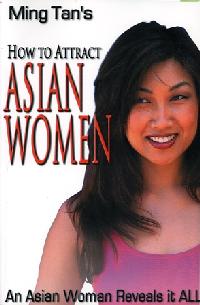
Ming Tan BridgeGap Books seems to Tan's own imprint. Asian Socials is the name of her website, which also sells her "self-help" book. The Table of Contents reveals the nature of her help.
Part 1: The Preference for Asian Women
1. Are Asian Women Different
from Non-Asian Women?
2. Why Men Prefer Asian Women
3. Should You Put Her on a Pedestal?
4. What Asian Women Think of Guys with the "Asian Fetish"
5. Do Asian Women Find Non-Asian Men Attractive
and Do They Want to Date Them?
6. Just for Asian Men
Part 2: Asian Culture
7. About Asians
8. The Various Asian Cultures
Part 3: How to Attract Asian Women
9. How to Enchant and Flatter that Special Asian Woman
10. How to Meet Asian Women on the Internet
11. How to Approach an Asian Lady
12. Eleven Things You Should Never Say to an Asian Lady
13. How to Act on a First Date with an Asian Woman
14. What to do to Get an Asian Woman to Go Out with You Again
15. What Makes a Man Sexy?
The back cover says "About the Author" that "Ming Tan, a Chinese-American writer who grew up in New York City, is the founder of a website that has helped numerous men understand and attract Asian women. She also hosts dating seminars and events for the Asian American Professionals Network. The New York Observer and New York Press have run articles regarding Ming Tan's activities." In the first paragraph of Chapter 1, Tan qualifies herself as "an Asian woman who has lived in the United States for over two decades" -- and who knows herself "to be different from other women" because her parents "instilled traditions and attitudes" in her "that account for the difference". Her website promises to help men of apparently all subspecies understand and attract Asian woman. Her professional activity seminars seem to be mostly about modeling. Read at your own riskThe blurb on the back cover suggests that Tan's advice is empirically grounded. Ever wished you could be a fly on the wall and listen to what some Asian women are saying to each other about dating, relationships and men? Now you can -- just read this book! This book includes hundreds of quotes from single Asian females about the subject. These Asian ladies ranged from age 19 to 58, most of them living in major cities in the United States. If you want to attract someone like one of them, listen to them! Tan, in her Acknowledgments, is grateful to all the Asian ladies who patiently answered her long list of questions. Yet immediately after the Acknowledgments comes this advisory.
How to tell if an Asian is an AsianReaders are therefore responsible for any problems they encounter in life as a result of believing the wrong half of what Tan says about Asians and eyelids in the first five pages of Chapter 1.
Sorry about cutting the white dude off at his pass. I simply don't wish to be accused of giving away Tan's plot. Reality checkHere is a short list of questions I would ask Tan concerning her observations about eyelids in Asia.
A number of authors of Steamy East thrillers, who might be accused of perpetuating other stereotypes about "Asians", are more reliable than Tan as observers of Asian anthropology and sociology. Asian IndiansIn Chapter 7, "About Asians", says that "Asians include: Chinese; Filipino; Japanese, Asian Indian; Korean; Vietnamese; Laotian; Thai; Cambodian; Pakistani; Indonesian and Hmong" (Page 63). This answers more than one of my questions, and otherwise undermines her obsession with monolids as the most "Asian" of facial traits. Tan then says that "Pacific Islanders include: Polynesian (Hawaiian, Samoan, and Tongan); Micronesian (Guamanian) and Melanesian (Fijian)" (ibid.). It is not clear why she mentions "Pacific Islanders" at all -- since she has no intention of including them among "Asians". Tan then tells us what "Asian" cohorts she intends to talk about in the chapter. The Asian culture section will focus on Chinese, Filipino, Japanese, Korean, Vietnamese, and Thai because these are the Asians most frequently encountered in the United States. "Asian Indians" -- who far outnumber Japanese, Koreans, Vietnamese, and Thai (who rank lower than Cambodians, Hmong, Laotians, Pakistani, and Taiwanese) in the United States -- might like to know why they are not "frequently encountered". And I would like to know why Tan -- who actually cites some Census 2000 figures and gives a URL to her source -- did not look at the breakdown by group. Census tabulations show the following breakdown by detailed group for the "Asian Population" in the United States in the year 2000. Asian Population by Detailed Group -- 2000
@@@@@@ @@@ Asian in
combination with
one or more
Asian alone other races
Asian
Two or Two or detailed
One more One more group
Asian Asian Asian Asian alone
Detailed group groups group groups or in any
group reported reported reported reported combination
Total 10,019,405 223,593 1,516,841 138,989 11,898,828
Asian Indian 1,678,765 40,013 165,437 15,384 1,899,599
Bangladeshi 41,280 5,625 9,655 852 57,412
Bhutanese 183 9 17 3 212
Burmese 13,159 1,461 1,837 263 16,720
Cambodian 171,937 11,832 20,830 1,453 206,052
Chinese 2,314,537 130,826 201,688 87,790 2,734,841
Filipino 1,850,314 57,811 385,236 71,454 2,364,815
Hmong 169,428 5,284 11,153 445 186,310
Indo Chinese 113 55 23 8 199
Indonesian 39,757 4,429 17,256 1,631 63,073
Iwo Jiman 15 3 60 - 78
Japanese 796,700 55,537 241,209 55,486 1,148,932
Korean 1,076,872 22,550 114,211 14,794 1,228,427
Laotian 168,707 10,396 17,914 1,186 198,203
Malaysian 10,690 4,339 2,837 700 18,566
Maldivian 27 2 22 - 51
Nepalese 7,858 351 1,128 62 9,399
Okinawan 3,513 2,625 2,816 1,645 10,599
Pakistani 153,533 11,095 37,587 2,094 204,309
Singaporean 1,437 580 307 70 2,394
Sri Lankan 20,145 1,219 2,966 257 24,587
Taiwanese 118,048 14,096 11,394 1,257 144,795
Thai 112,989 7,929 27,170 2,195 150,283
Vietnamese 1,122,528 47,144 48,639 5,425 1,223,736
Other Asian 146,870 19,576 195,449 7,535 396,430
Source: US Census Bureau, Census 2000
OrientalsTan gives this advice about "Orientals" (page 63). Do not refer to Asians as "Orientals." Many Asians take offense when people call them Orientals, which conveys images of colonialism and the exotic Orient. The world "Oriental" has connotations to objects such as rugs; Asians are people. Is "The Asian eyelid fold" not an object? Is "Asian culture" not also an object? Is Tan's racialization of certain people as "Asians" not also an act of objectification? I rather think the objection to "Orientals" has more to do with plain old-fashioned political correctness. (WW) |
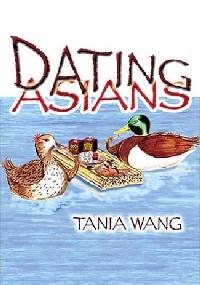
Tania Wang Wang is billed as a Los Angeles-based "multi-talented content provider" -- whatever that means. Apparently was born and raised in Taiwan, has a background in cultural anthropology, moved to Los Angeles in 1994 as an aspiring actress, and soon discovered that there was no market for Asian actors. Whatever inspired her to write Dating Asians, she is said to hope that her book "will enlighten many uninformed Asian-seekers with her insightful, entertaining and invaluable observations into Asian attitudes and expectations." More to come when book arrives. (WW) |
| Blending bloods |
|
To the extent that people see each other as fruit, they recognize "hybrids" between black, brown, red, white, and yellow fruits, or between German and Japanese fruits, or between Earthlings and Martians. See Eurasians under "Raciosexual images" in the "Images" section of Steamy East for reviews of books and commentary on Eurasians and other racial blends in English fiction. |
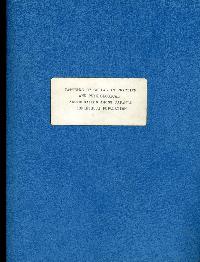
Nathan Oba Strong Nathan Strong, while doing his research in Japan, sometimes went undercover, passing himself off as a person of mixed black and yellow ancestry. He blew his cover at least once, but he could be very convincing. He also did something else rather remarkable for a field worker under the direction of George De Vos and Hiroshi Wagatsuma -- he went against the grain of their professional interests in the darker side of minority status, and found that not a few of his subjects were as happy with their lot as anyone else. Strong went on to become a professor and administrator at colleges in Oakland and Alameda, south and north of Berkeley. DisclosureI met Strong when both of us were graduate students at UC Berkeley. We did our doctoral research in Japan at the same time, and were in constant touch about each other's work, and about dealing with De Vos and Wagatsuma. Strong gave me copies of some of the primary materials he collected from Sawada Miki, who passed away a couple of years after he filed his dissertation. His dissertation includes several full-page facsimiles of clippings which I provided him, of Japanese magazine ads featuring people of putatively "mixed blood". For further details, see comments in my review of Burkhardt 1983. |
